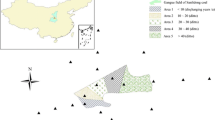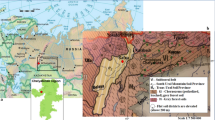Abstract
Fast-growing metal-accumulating woody plants are considered potential candidates for phytoextraction of metals. Shuikoushan mining, one of the biggest Pb and Zn production bases in China, presents an important source of the pollution of environment during the last 100 years. Over 150 km2 of fertile soil have been contaminated by the dust, slag, and tailings from this mining. The goal of the present work has been to determine the content of Pb, Zn, Cd, and Cu in wild woody plants (18 species) naturally growing in this area. Two hundred five plant and soil samples from 11 contaminated sites were collected and analyzed. In addition, to assess the ability of multi-metal accumulation of these trees, we proposed a predictive comprehensive bio-concentration index (CBCI) based on fuzzy synthetic assessment. Our data suggest some adult trees could also accumulate a large amount of metals. Pb concentrations in leaves of Paulownia fortunei (Seem.) Hemsl. (1,179 mg/kg) exceeded the hyperaccumulation threshold (1,000 mg/kg). Elevated Pb concentrations (973.38 mg/kg) were also found in the leaves of Broussonetia papyrifera (L.) Vent., with a Pb bio-concentration factor of up to 0.701. Endemic species, Zenia insignis Chun exhibited huge potential for Zn and Cd phytoextraction, with the highest concentrations of Zn (1,968 mg/kg) and Cd (44.40 mg/kg), characteristic root nodules, and fast growth rates in poor soils. As for multi-metal accumulation ability, native species B. papyrifera was calculated to have the most exceptional ability to accumulate various metals simultaneously (CBCI 2.93), followed by Amorpha fruticosa L. (CBCI 2.72) and Lagerstroemia indica L. (CBCI 2.53). A trend of increasing metal from trunks to leaves (trunks < branches < leaves) and towards fine roots has been shown by metal partitioning between tissues. The proposed CBCI would allow for the selection of suitable trees for phytoremediation in the future.




Similar content being viewed by others
References
Assunção AG, Pieper B, Vromans J, Lindhout P, Aarts MG, Schat H (2006) Construction of a genetic linkage map of Thlaspi caerulescens and quantitative trait loci analysis of zinc accumulation. New Phytol 170:21–32
Azzarello E, Pandolfi C, Giordano C, Rossi M, Mugnai S, Mancuso S (2012) Ultramorphological and physiological modifications induced by high zinc levels in Paulownia tomentosa. Environ Exp Bot 81:11–17
Baker A, McGrath SP, Reeves RD, Smith J (2000) Metal hyperaccumulator plants: a review of the ecology and physiology of a biological resource for phytoremediation of metal-polluted soils. In: Terry N, Banuelos G (eds) Phytoremediation of contaminated soil and water. Lewis Publishers, Boca Raton, pp 85–107
Basic N, Salamin N, Keller C, Galland N, Besnard G (2006) Genetic differentiation of Thlaspi caerulescens natural populations in relation to their cadmium hyperaccumulation capacity. Biochem Syst Ecol 34:667–677
Bert V, Bonnin I, Saumitou-Laprade P, Laguérie P, Petit D (2002) Do Arabidopsis hallerifrom non-metallicolous populations accumulate zinc and cadmium more effectively than those from metallicolous populations? New Phytol 155:47–57
Bhargava A, Carmona FF, Bhargava M, Srivastava S (2012) Approaches for enhanced phytoextraction of heavy metals. J Environ Manage 105:103–120
Chen QZ, Timo S, John S (2012) Assessment of agri-environmental public goods provision using fuzzy Synthetic evaluation. Discussion papers, University of Helsinki, Department of economics and management. Number 61
Danh LT, Truong P, Mammucar R, Tran T, Foster N (2009) Vetiver grass, Vetiveria zizanioides: a choice plant for phytoremediation of heavy metals and organic wastes. Int J Phytoremediation 11:664–691
Di Lonardo S, Capuana M, Arnetoli M, Gabbrielli R, Gonnelli C (2011) Exploring the metal phytoremediation potential of three Populus alba L. clones using an in vitro screening. Environ Sci Pollut Res Int 18:82–90
Douay F, Roussel H, Pruvot C, Loriette A, Fourrier H (2008) Assessment of a remediation technique using the replacement of contaminated soils in kitchen gardens nearby a former lead smelter in Northern France. Sci Total Environ 401:29–38
Doumett S, Lamperi L, Checchini L, Azzarello E, Mugnai S, Mancuso S, Petruzzelli G, Del Bubba M (2008) Heavy metal distribution between contaminated soil and Paulownia tomentosa, in a pilot scale assisted phytoremediation study: influence of different complexing agents. Chemosphere 72(10):1481–1490
Fasani E (2012) Plants that hyperaccumulate heavy metals. In: Furini A (ed) Plants and heavy metals. Springer, Berlin Heidelberg, pp 55–74
Fernando DR, Bakkaus EJ, Perrier N, Baker AJ, Woodrow IE, Batianoff GN, Collins RN (2006) Manganese accumulation in the leaf mesophyll of four tree species: a PIXE/EDAX localization study. New Phytol 171:751–758
Garg A, Achari G, Joshi RC (2006) A model to estimate the methane generation rate constant in sanitary landfills using fuzzy synthetic evaluation. Waste Manag Res 24:363–375
Glass DJ (1999) U.S. and international markets for phytoremediation, 1999–2000. Industry Report. D. Glass Associates, Inc. Needham, Massachusetts, USA
Hall JL (2002) Cellular mechanisms for heavy metal detoxification and tolerance. J Exp Bot 53(366):1–11
Harada E, Hokura A, Nakai I, Terada Y, Baba K, Yazaki K, Shiono M, Mizuno N, Mizuno T (2011) Assessment of willow (Salix sp.) as a woody heavy metal accumulator: field survey and in vivo X-ray analyses. Metallomics 3(12):1340–1346
He WM, Ma FY (2000) Effects of water gradient on fluorescence characteristics and gas exchange in Sabina vulgaris seedlings. Acta Phytoecologica Sinica 24(5):630–634 (in Chinese)
He J, Ma C, Ma Y, Li H, Kang J, Liu T, Polle A, Peng C, Luo ZB (2013) Cadmium tolerance in six poplar species. Environ Sci Pollut Res 20(1):163–174
Khan S, Cao Q, Zheng YM, Huang YZ, Zhu YG (2008) Health risks of heavy metals in contaminated soils and food crops irrigated with wastewater in Beijing, China. Environ Pollut 152(3):686–692
Krämer U (2010) Metal hyperaccumulation in plants. Annu Rev Plant Bio 61:517–534
Liu XH, Gao YT, Sardar K, Duan G, Chen AK, Ling L (2008) Accumulation of Pb, Cu, and Zn in native plants growing on contaminated sites and their potential accumulation capacity in Heqing
Maestri E, Marmiroli M, Visioli G, Marmiroli N (2010) Metal tolerance and hyperaccumulation: costs and tradeoffs between traits and environment. Environ Exp Bot 68:1–13
Maric M, Antonijevic M, Alagic S (2013) The investigation of the possibility for using some wild and cultivated plants as hyperaccumulators of heavy metals from contaminated soil. Environ Sci Pollut Res 20(2):1181–1188
McGrath SP, Zhao FJ (2003) Phytoextraction of metals and metalloids from contaminated soils. Curr Opin Biotechnol 14:277–282
Mi C, Zhang X, Li S, Yang J, Zhu D, Yang Y (2011) Assessment of environment lodging stress for maize using fuzzy synthetic evaluation. Math Comput Model 54:1053–1060
Onkal-Engin G, Demir I, Hiz H (2004) Assessment of urban air quality in Istanbul using fuzzy synthetic evaluation. Atmos Environ 38:3809–3815
Pedron F, Petruzzelli G, Barbafieri M, Tassi E (2009) Strategies to use phytoextraction in very acidic soil contaminated by heavy metals. Chemosphere 75(6):808–814
Peuke AD, Rennenberg H (2005) Phytoremediation. Embo Rep 6:497
Pulford ID, Watson C (2003) Phytoremediation of heavy metal-contaminated land by trees—a review. Environ Int 29:529–540
Puschenreiter M, Türktaş M, Sommer P, Wieshammer G, Laaha G, Wenzel WW, Hauser MT (2010) Differentiation of metallicolous and non-metallicolous Salix caprea populations based on phenotypic characteristics and nuclear microsatellite (SSR) markers. Plant Cell Environ 33(10):1641–1655
Raju D, Sunil K, Urmil JM, Hazra S (2008) Differential accumulation of manganese in three mature tree species (Holoptelia, Cassia, Neem) growing on a mine dump. Curr Sci (Bangalore) 94:639–643
Sarma H (2011) Metal hyperaccumulation in plants: a review focusing on phytoremediation technology. J Environ Sci Tech 4:118–138
Seo KW, Son Y, Rhoades CC, Noh NJ, Koo JW, Kim JG (2008) Seedling growth and heavy metal accumulation of candidate woody species for revegetating Korean mine spoils. Restor Eco 16(4):702–712
Shi X, Zhang X, Chen G, Chen Y, Wang L, Shan X (2011) Seedling growth and metal accumulation of selected woody species in copper and lead/zinc mine tailings. J Environ Sci 23(2):266–274
Sun R, Shu F, Hao W, Li L, Sun WL (2011) Heavy metal contamination and Pb isotopic composition in natural soils around a Pb/Zn mining and smelting area. Environ Sci 32:1146–1153 (in Chinese)
Unterbrunner R, Puschenreiter M, Sommer P, Wieshammer G, Tlustoš P, Zupan M, Wenzel WW (2007) Heavy metal accumulation in trees growing on contaminated sites in Central Europe. Environ Pollut 148:107–114
Wang X, Jia Y (2010) Study on adsorption and remediation of heavy metals by poplar and larch in contaminated soil. Environ Sci Pollut Res Int 17(7):1331–1338
Wang J, Zhang CB, Jin ZX (2009) The distribution and phytoavailability of heavy metal fractions in rhizosphere soils of Paulownia fortunei (seem) Hems near a Pb/Zn smelter in Guangdong, PR China. Geoderma 148:299–306
Wei C, Wang C, Yang L (2009) Characterizing spatial distribution and sources of heavy metals in the soils from mining-smelting activities in Shuikoushan, Hunan Province, China. J Environ Sci 21:1230–1236
Xue l, Liu JF, Shi SQ, Wei Y, Chang EM, Gao M, Chen LZ, Jiang ZP (2013) Uptake of heavy metals by native herbaceous plants in an antimony mine (Hunan, China). ClEAN-soil, air, water. Accepted Articles
Zadeh LA (1996) Fuzzy sets, fuzzy logic and fuzzy systems: selected papers of Lotfi A. Zadeh. World Scientific Publishing, Singapore
Acknowledgments
This work was supported by the Ministry of Science and Technology, China (2011BAD0103 and 2012BAC09B03). The authors are grateful to Dr. Fang-Ping Tong and Zhen-Hua Liu at the Research Institute of Forestry, Hunan Academy of Forestry, China, for their continuous support during the experiment.
Author information
Authors and Affiliations
Corresponding author
Additional information
Responsible editor: Elena Maestri
Xiulian Zhao and Jianfeng Liu contributed equally to the article.
Rights and permissions
About this article
Cite this article
Zhao, X., Liu, J., Xia, X. et al. The evaluation of heavy metal accumulation and application of a comprehensive bio-concentration index for woody species on contaminated sites in Hunan, China. Environ Sci Pollut Res 21, 5076–5085 (2014). https://doi.org/10.1007/s11356-013-2393-3
Received:
Accepted:
Published:
Issue Date:
DOI: https://doi.org/10.1007/s11356-013-2393-3




